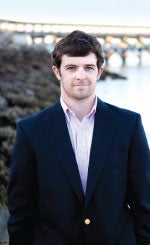They are two sides of the same coin. The yin and the yang. The very archetype of symbiosis. And, now more than ever, they depend on one another for survival.
Yet, as clearly related as they might be, the public and the environment have long been approached as unrelated academic disciplines: policy vs. science, social vs. systematic, people vs. nature, flexible vs. precise. But all that is changing.
With its Environmental Studies and Public Administration Dual Degree Program, the College’s Graduate School isn’t just acknowledging the intricacy of human-environment interactions – that people affect the environment and environmental changes affect people – but it’s responding to the growing number of public and nonprofit organizations addressing today’s sustainability and environmental issues.
The program prepares students for environmental-policy careers in the public sector, allowing them to earn both a Master of Environmental Studies (M.E.S.) and a Master of Public Administration (M.P.A.) in just 56 credit hours of inter-disciplinary courses.
As long as the two fields have been intertwined, the cross-section of science and policy is something new for most students, who are coming from either a science background or a policy background, but not both.
“I think it’s a little bit more challenging for anyone coming in from a strict policy background, but they can survive,” says Lowell Atkinson (M.E.S./M.P.A.) ’12, who studied political science as an undergraduate. “I almost quit one course, Energy Production and Resource Management. I just had so little confidence in anything mathematical or technical like that. But I stuck with it, and it ended up being my favorite course. It challenged me a good bit. But it was very rewarding.”
Already in the College’s M.P.A. program, Atkinson joined the dual-degree program because he’d become interested in the environmental side of his job at the Charleston County Building Inspections Department, where he was working under an EPA-funded grant that raised awareness about Charleston’s air and water quality.
“It just seemed like the perfect fit – and a great way to further my interest in environmental policies,” he says.
Liz Symon ’05 (M.E.S./M.P.A. ’12) had a similar experience, only she was coming from the opposite perspective. As an undergraduate at the College, she’d studied marine biology with a concentration in environmental studies, and had already begun the M.E.S. program when she decided to commit to the dual-degree program.
“In the beginning, I thought I was going to concentrate more on the science side of things,” she says. “All it took was that first class, and I definitely shifted more into the policy side. I liked that there was the flexibility to choose your focus. For me, it was the best of both worlds.”
Both she and Atkinson are confident that employers will see it that way, too.
“Job opportunities aren’t that robust now,” says Atkinson, a program associate for the S.C. Association of Community Development Corporations, “but when it rebounds, they’re going to be looking for people with this kind of background.”
“I feel like I can apply to a wider array of jobs because I have the ability to go into an environmental organization and take a more executive position. I can basically do any of the jobs I want to do,” agrees Symon, who is currently looking for work with natural resource/environmental education organizations. “Ultimately, I want to know I’m making a difference for the greater good, especially with renewable energy. I want to help advance the practice of it through education and outreach.”
And, while Symon is going from a background in marine biology to a future in education and outreach, Atkinson is refocusing his own background in policy – now with a clear goal of protecting both the public and the environment.
“In whatever job I take, my mission will be to enhance community resilience and decrease social vulnerability through ecological protection and restoration,” he says. “Basically, I want people to understand the connectivity between ecology and society.”
And that connection is what the program is all about.







